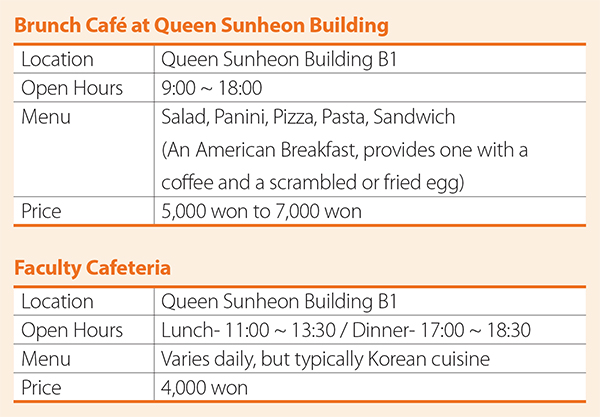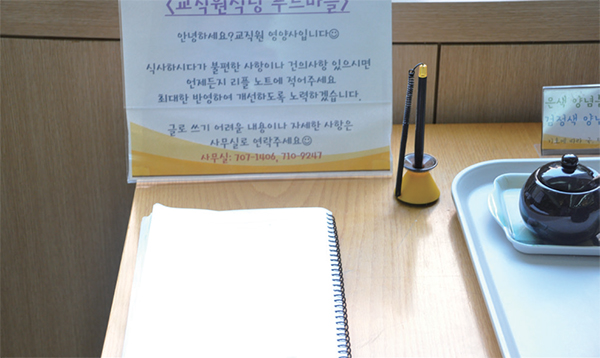
After every class ends, Sookmyungians look for the best place to eat their lunch or snack. However, lots of students go out for food rather than going to nearest cafeteria in campus. With having problems of raising charge and bad service, there was even a Sookmyung food truck by the student union as a substitution of using the cafeteria among students. Then, why don’t students actively use cafeteria in campus? The Sookmyung Times tried to find out some faults of school cafeteria.
Sookmyungians Eat Here and There
Lunch time is the time when most of the students wait for during the class. Unlike middle school and high school, in university, the lunch time is not fixed. In addition, there are many places to eat the meal. Then, let’s take a look at SMU’s cafeterias.
Other than these, referring to the Sookmyung Times No. 301, SMU has many places to deal lunch and dinner. However, nowadays, SMU students aren’t that satisfied with the school cafeteria often. Now, most of the students go outside and eat at restaurants near campus or buy sandwich and snack and eat them during break time.

No Longer Eating Here nor There
The problems with SMU cafes and cafeterias are two-fold: quality and service. In terms of food quality, SMU food is quite expensive. SMU cafeteria Café Snow offers the cheapest dish Tonkatsu, but generally on average it’s 4,000 won a meal. Compared to Seoul National University, most meals only cost 3,000 won. In addition, at Kyunghee University Kimchi Tonkatsu is only 2,500 won, which is much cheaper than SMU’s Tonkatsu. Moreover, the taste is not as good as the price. The Sookmyung Times surveyed 200 students and 22% said that SMU food was bad when compared to other universities. Shockingly, one student, on SMU’s community website SnoWe, posted a comment that the food from Café Hyu, located in the Main Library, was the worst among all cuisine from other cafes and cafeterias on campus. Furthermore, many students feel the quality of food is poor and that side dishes seldom differ. Lee Hyunji, Department of Mathematics ’13 said “Every lunch at school provides almost the exact same side dishes. Typically, there is always kimchi, yellow pickled radish. Also, after eating, I rarely feel full.” Besides complaints about side dishes, the menu at each food place on campus is pretty much the same. Students want more diverse menu. Since there are many problems among food quality, students think that the price is too expensive. 43% of students said the price should be reduced to between 2,000 won and 2,500 won.
Another problem with the food eateries is the service. Last semester, one part-timer at the brunch café in Queen Sunheon Building treated students badly. As the employee threw away the trash, he spoke ill of SMU students. When this news spread to other students, SMU was very furious. To solve the problem, Shinsagae Food, the company that SMU contracts its school food provision to, posted apology letter on the community website and fired the employee that used the inappropriate language.
When students complained about the cafeteria food, Shinsagae Food apologizes and responds with “This will not happen again.” When a student says there is something wrong with her kimbab, the employee of the company responds with sorry and provides another roll of kimbab free. To enhance the quality of food, the 47th student council Reflying is now visiting other universities whose eateries have received favorable comments. The council also vowed that when the semester starts, it is going to survey students’ opinion on school food. Lastly, Reflying is trying to catch hold of the contract with Shinsagae Food, and together they are trying to best met demands.



Let the Students Be Satisfied
Many problems are unsolved at SMU. To resolve the situation, the school first needs to monitor eateries on campus. In 2012, SMU’s student council organized a club that did such work in order to deal with cafeteria problems. However, the 2013 student council abandoned that initiative. SMU needs long term eatery monitoring. For instance, Ewha Womans University started eatery monitoring in 2011. All year long, Ewha’s student council selects students to monitor the food places. In addition, there is information of when to register for the student monitoring program on the main website of Ewha Womans University. Lee Yaeji, Division of Nursing Science ’14 of Ewha Womans University said “One of my friends works as a student monitor. When I had a complaint about my food, she mentioned it during her club meeting. Soon after that, the quality of the food became much better.”
Another solution is to make a student cooperative association and let it run the school cafeteria. Kookmin University and Hankuk University of Foreign Studies (HUFS) have eateries run by this type of association. The student cooperative association allows students to have a better campus life by reducing the price of food, even lower than at other universities. At HUFS, the price of a meal is between 1,800 won and 2,200 won. Not only is the price cheap, the food is delicious. On HUFS’ community site, many students say they are very satisfied with their food at their school. Because of good link between price and food quality, students from other universities go there to eat. Kookmin University is well known for its cheap and delicious food. Ramen at Kookmin University costs 1,500 won, which is 700 won cheaper than at SMU. Additionally, the most expensive meal is pork cutlet, which is 3,000 won. Like Kookmin and HUFS, eateries operated by a student cooperative association lets students eat great quality at low process than ones operated by private company.
Lastly, students should have a voice in who manages the food on campus. At present, the food and meals are all managed by Shinsagae Food. However as aforementioned, many students are very upset with Shinsagae Food in terms of food quality and service. In 2013, there was a price increase. The student council wanted to break the contract with Shinsagae and make a deal with another food company. When students are upset, it is the school responsibility to listen to students’ voice and respond. However, before asking students to vote on a food company, the school needs to inform students about taste and available companies. For instance Yonsei University has a contract with Well Story and Our Home for its school cafeteria. Likewise, food from other companies can be more tasty and satisfying. Therefore, students need to give an informed vote about companies. If the above one is impossible, SMU should, in the very least, listen to student outcry and reflect their voice.

The Real Means of SMU Cafeteria
A university eatery is the best place for students to eat lunch cheaply and since it is on campus, students who have afternoon classes can eat quickly. 48% students of surveyed students said they eat on campus two or three times a week. However, these days, satisfaction with the eateries is poor. Since students want to eat tasty food for lunch, they eat off campus even though the price is much more expensive than the cafeteria. If this situation continues, the meaning of campus eatery will become useless. For a better environment, students, the school and the company must work together. Students need to voice themselves, and the school and the company need to listen. Also, the food service provider needs to create a clean eating environment. When all three work together, SMU will become as famous as other universities in terms of eating on campus. Let’s dream that one day, SMU students will eat happily on campus and that the company and school are grinning back on students as they eat.


